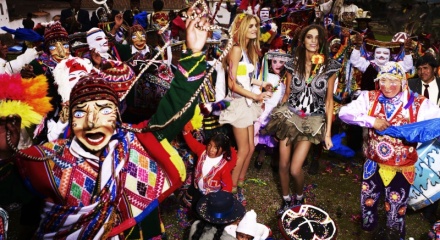A DIGITAL FASHION EXHIBIT
The borrowing of ethnic references in 20th century clothing is intrinsically problematic. If art historians argue that art is always connoted with ideological intensions, fashion makes no exception. Especially in this postcolonial era, cultural and visual strategies are embedded in asymmetrical relationships between the represented ethnicities and the dominant Westerners. And as we reach a climax of … Continue reading
SOCIAL AND HISTORICAL CONTEXT
“Since clothing is inescapably a demonstration of identity, wearing clothes […] is inevitably a political act […].” (Ross 2008, 12) Clothing is a socially driven practice as it displays hierarchy and power structures. Rules from various empires established dress codes to exert control over their subjects, order civilians and secure social immobility: “clothing has been … Continue reading
PART ONE – Fashion Design : Garment as a site of social transformation and travel
The first part of the exhibition will walk the viewer through the works of designers Yves Saint Laurent and Jean Paul Gaultier, while contrasting these designs with original traditional costumes. The parallel depiction of these Western designers with traditional costumes will serve to make the viewer aware of the evolution of the appropriation of foreign … Continue reading
YVES SAINT LAURENT – MOROCCAN MEMORIES & IMAGINARY TRAVELS
The rise of globalized and widely diffused sartorial trends coincides in the middle of the 20th century with the development of prêt-à-porter. Prêt-à-porter, as opposed to Haute Couture, involves distinct market behaviours, being priced more accessibly and adapted to casual dressing. One designer especially involved in the popularization of prêt-à-porter is Yves Saint-Laurent, “one of the … Continue reading
YSL – SELECTED ITEMS
Yves Saint Laurent in Marrakech, 1960s NORTH AFRICA & MOROCCO “On each street corner in Marrakech, you encounter groups that are impressive in their intensity, their relief. Men and women, where pink, blue, green, and violet caftans mingle. These groups look as if they have been drawn and painted, that are reminiscent of sketched by Delacroix, … Continue reading
JPG – SELECTED ITEMS
“Par transpositions, détournement, et assemblages, il donne forme à des métissages transfrontières. Les mondes et les individus déparés par le barrage de la langue, des coutumes et de la géographiese fondent en un univers dont le passeport est tamponné “Planète JPG”. Le couturier orchestre par le vêtement le dialogue entre les cultures et les races. … Continue reading
Recontextualized Fashion Editorial – Trail Blazers
Mario Testino, Trail Blazers (Daria Werbowy & Lily Donaldson), Vogue UK, March 2008 Mario Testino’ s March 2008 Vogue UK editorial featuring Daria Werbowy and Lily Donaldson took place in Cusco, Peru, where the two models are depicted as backpack travelers encountering this exotic culture. Their status of visitors is confirmed across the photographic series, … Continue reading
Recontextualized Fashion Editorial – Pachamama
Thierry Le Gouès, Pachamama (Meghan Collision & Solange Wilver), Cuzco, French Revue de la Mode, 2010 Le Gouès attempted to directly relate and connect the models with the locals, without the mediation of a traveler/tourist’s status, by using an ethnographic voice. By alternating black and white photos of the locals in their daily occupations with … Continue reading
Decontextualizated Fashion Editorial – Multi-Ethnic Gallery
Paolo Roversi, Multi-Ethnic Gallery, Vogue Italia, January 2013. Paolo Roversi’s Multi-Ethnic Gallery displays ethnic inspired designs worn by models from the country suggested by the clothes and the captions. Such a choice highlights the potential intention of the photographer to construct a feeling of authenticity. From a formal perspective, the treatment of the image evokes an … Continue reading
CONCLUSION
The role of fashion images in the reinforcement of a biased Western gaze can take place both on garments and in fashion photography. The clothes we wear and endorsee are a means by which to express our sense of self and affiliation with our culture and ingroup. Thus, endorsing ethnic sartorial behaviours implies this double … Continue reading












